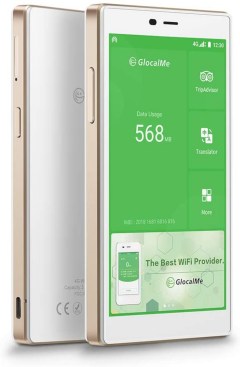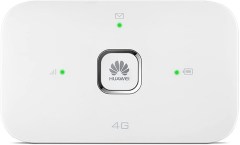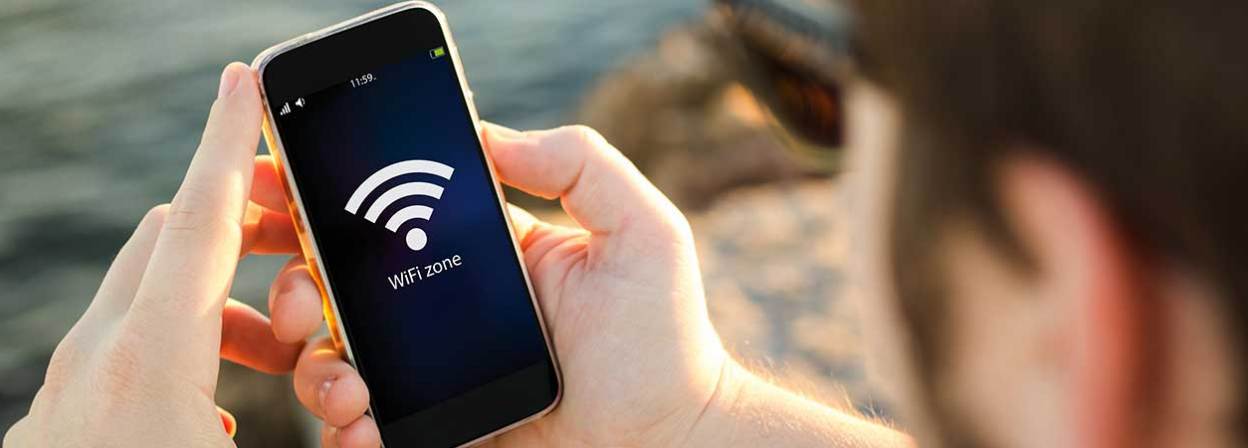BestReviews is reader-supported and may earn an affiliate commission. Details

A mobile hotspot with coverage in most countries, high-speed connection, and long battery life.
Can be used in over 140 countries. Hotspot also doubles as a power bank for on-the-go charging. Long battery life of 18 hours for a more reliable connection. Over 150-Mbps download speeds make it quick for a mobile hotspot.
A bit heavy for a portable hotspot device.

An attractive global mobile hotspot that offers both 2.4GHz and 5GHz WiFi bands.
Works in over 160 countries. Push-button setup. Uses the GSM network out of the box. Comes with several U.S. data plans and 1 GB of global data. Broadcasts in 2.4 GHz and 5 GHz to up to 5 simultaneous connections.
Tops out at 4G/LTE and 150 Mbps.

Simple yet effective, this mobile hotspot is a solid solution if 5G is unavailable in your area.
Fast 4G connectivity. Connect up to 10 devices at once. Convenient touchscreen. Utilizes dual-band WiFi for a solid connection. Affordable. Works with T-Mobile and AT&T networks.
The 10 hours of battery life is on the low side.

Special features make this reliable mobile hotspot perfect for international travel.
Offers global plans that allow free travel without needing local SIMs or accounts. Comes with 1GB initial global data and offers different data plans based on location. Connects up to 5 devices at a time. Lasts 15 hours per charge.
Power button is easy to accidentally turn on.

A solid hotspot that can connect 16 devices at once while maintaining decent speeds.
Good hotspot for traveling, especially overseas. The 6-hour battery life is enough to last a full day of usage. Offers 150-Mbps download and over 40-Mbps upload speeds. Works consistently with different kinds of devices from laptops to gaming consoles.
Setup is not user-friendly.

We recommend these products based on an intensive research process that's designed to cut through the noise and find the top products in this space. Guided by experts, we spend hours looking into the factors that matter, to bring you these selections.

WiFi can be hard to come by sometimes, and in those cases, the best option is often a mobile hotspot. Mobile hotspots are small black boxes that have one job: they connect to a cellular data provider’s network and use it to power a standalone WiFi access point. With a mobile hotspot, you can provide WiFi for multiple devices and even network them together — it’s basically a portable wireless router that uses carrier data.
Naturally, mobile hotspots come with monthly subscription fees, but most wireless providers will give you a discount if you add it to your existing smartphone data plan.
Whether you need to make sure everyone on your family vacation gets good WiFi, or you travel alone with multiple devices that need to connect to the web simultaneously, a mobile hotspot guarantees you’ve always got an internet connection.
The right mobile hotspot for you will vary on a few different factors, like your current wireless provider and the number of devices you’ve got. Here’s everything you need to know to find the perfect hotspot.

It’s important to buy a mobile hotspot that will work with your current wireless carrier (otherwise, you won’t be able to get online). AT&T and T-Mobile both use GSM networks, while Verizon uses a CDMA network. Most mobile hotspots are built for GSM networks, so if you’re a Verizon user, you’ll need to find one that’s explicitly labeled as compatible with your network.
Most mobile hotspots are only made to support roughly 5 devices at a time, although more expensive models can support as many as 15 active simultaneous connections. Estimate the total number of devices you expect might use your mobile hotspot and buy one that can keep up.




















There’s a lot of variety across the mobile hotspot market, so it pays to know ahead of time what features you want. Here are the most critical features to keep tabs on.
All of the big wireless carriers — and plenty of the little ones, too — offer month-to-month data plans that don’t require a contract. Your mobile hotspot is going to need to be added to a wireless plan, and if you don’t want to sign a service contract, you’ll need to find a mobile hotspot that’s compatible with a pay-as-you-go plan. Which devices are approved for these plans will vary by carrier, so if you plan to pay monthly, you’ll need to make sure to buy a mobile hotspot that your carrier supports.
Some mobile hotspots have USB ports, which you can use to hardwire your computer’s connection to mobile data instead of using WiFi. That can be handy for getting extra-fast speeds, but the real benefit of a USB 3.0 port is how fast it can charge your hotspot. Pick up a mobile hotspot that can charge via USB 3.0, so you’re never stuck waiting around for it to recharge.
Currently, the fastest mobile networks run at LTE speeds, but last-generation networks were considerably slower (if you lived through the days of 3G, you probably remember how painfully slow the web could be). Watch out for mobile hotspots that only operate at 3G speeds, and avoid them like the plague — and make sure any mobile hotspot you buy is compatible with LTE speeds.
Mobile hotspots for GSM networks like AT&T’s or T-Mobile’s usually run between $50 and $100. Models in this range offer full support for LTE speeds domestically and usually support five simultaneous connections. If you’re an AT&T or T-Mobile customer and you need the simplest option for getting WiFi anywhere, you won’t need to spend much.
For a mobile hotspot for Verizon, you’ll need to spend anywhere between $100 and $150. Models in this price range often include fancier features like touchscreens or high-capacity batteries.
Mobile hotspots that cost more than $200 are typically global models, meaning they’re designed to work in any country around the world. If you frequently travel the world and often find yourself needing data in foreign countries, you’ll need to spend a considerable amount on the right mobile hotspot. If you’re only going to be using your mobile hotspots domestically, you don’t need to spend as much.
Check your smartphone to see how much cellular data you typically consume over time. Both Android and iOS keep tabs on how much data you use when you’re not on WiFi, so it’s simple to check in on your data usage if you need to. Check your smartphone’s settings to get a sense of how much data you use in a given week or month, and then use that for information about which mobile hotspot you buy and the accompanying data plan you sign up for.
Buy a carrying case. Mobile hotspots have internal components that you’ll want to keep safe, so pick up a carrying case to protect it from the occasional fall. Cases are cheap, and peace of mind is priceless, so it’s an easy decision.

A. If you’re only connecting a handful of devices, yes. If you plan on connecting a full home’s worth of devices or multiple devices for other users, it’s not a great idea. Mobile hotspots are ideal for situations where you need fast WiFi in a pinch — like at hotels or airports — but they’re not really designed to do all of the heavy-lifting of a proper home internet connection. (Even if they could, wireless providers would slow down your data speeds if you consume too much from them, in a common practice known as throttling.)
A. Probably. Subscriber Identity Module, or SIM, cards used to be only for some wireless carriers, but they’re now required for any mobile device on a carrier data plan. You’ll need to buy a SIM card for your mobile hotspot directly from your wireless provider (so that it can be registered to your account), but they’re usually less than $20.
A. It depends, but probably not. Mobile hotspots use cellular radios just like your smartphone, and performance will always depend on reception. If you have a particularly old phone with outdated hardware, a mobile hotspot may give you a nice boost, but for the most part, your mobile hotspot will get the same reception your smartphone does — for better or for worse.
Get emails you’ll love.
Learn about the products you’re wondering if you should buy and get advice on using your latest purchases.
